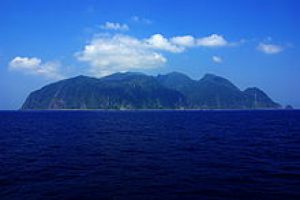
In just a few days, the Dolphin Communication Project will begin our research on Mikura Island in Japan for our summer 2007 field season. The tiny, dormant volcanic island of Mikura lies 200 km south of Tokyo in the Pacific Ocean. The island is home to 300 human beings and about 180 Indo-Pacific bottlenose dolphins. These dolphins live in the shallow waters around the island. The dolphins have been studied systematically since 1994, and researchers now have a complete catalog of most of the individual dolphins that live around the island.
It appears that the Mikura dolphins will, for the most part, spend their entire lives around this island. The shallow waters provide them shelter and protection – a fantastic place for young mother dolphins to raise their vulnerable calves. The deeper waters of the open ocean are home to a variety of predators like sharks; staying in the shallow waters gives the dolphin mothers a better chance at spotting an approaching shark, and so they will often stick close to shore when resting or socializing. The shoreline area functions a bit like a dolphin nursery.
Each of the dolphins around Mikura has been given a name and an ID number. Researchers are able to tell the dolphins apart because of individual scars and spots that the dolphins acquire as they age. Young dolphins are often hard to tell apart, but the older dolphins – many of whom might be more than 40 years old – are full of scars from shark attacks or even from fights with other dolphins. One shark in particular, the cookie cutter shark, is responsible for most of the scars that we see on these dolphins. It is not a very big shark – only 50 cm in length – but it has nasty sharp teeth and a taste for dolphin flesh. They live in the deeper water where dolphins forage for fish. When a dolphin swims by searching for fish, the cookie cutter shark will latch onto the dolphin’s flank and take a mouthful of flesh. This very rarely results in a fatality, but does result in a meal for the shark (feeding from a kind of mobile dolphin buffet), and unfortunately for the dolphin, will generally leave a very nasty round scar that the dolphin will carry for life.
Using these scars, members of our research team are able to keep track of the comings and goings of most of the individual dolphins around the island. We keep records of the birth of calves and have documented several successful cases of dolphin grandmothers, having followed the birth of several calves over 3 generations.
This year, the DCP research team will spend a little over a month on Mikura, collecting all kinds of data on these dolphins. We ride along with the eco-tour vessels run by local boat captains and swim with the dolphins using snorkel gear. The dolphins, after all these years of co-habitation with Mikura residents and tourists, are habituated to the presence of both boats and swimmers, and appear tolerant of our presence. Using special underwater video equipment, we are able to record both video and stereo audio of the dolphins going about their daily lives. We watch them socializing, mating, fighting, playing, forging, and sleeping. We use these data for a variety of studies that we are conducting on behavior, including research into communication and echolocation.
I invite all Dolphin Pod listeners to join me out on Mikura (in a virtual kind of way) for this season’s research. I will be keeping a daily blog about my research this summer. Check it out at the Dolphin Communication Project website – that is www.dolphincommunicationproject.org – click on Research Field Reports and then Japan May – July 2007. Or, look for a link to my reports on the Dolphin Pod website. Feel free to drop me a line!
More soon from Mikura!
